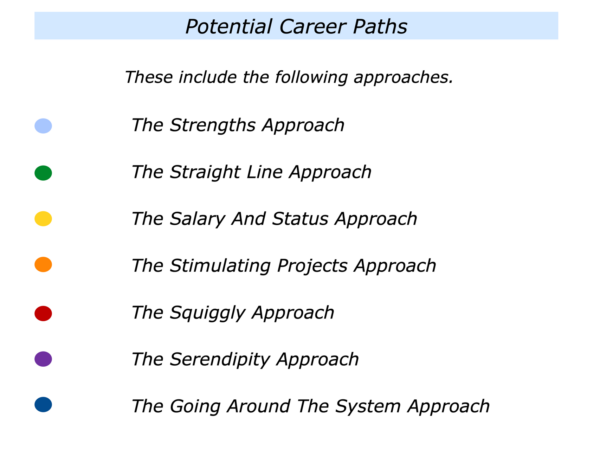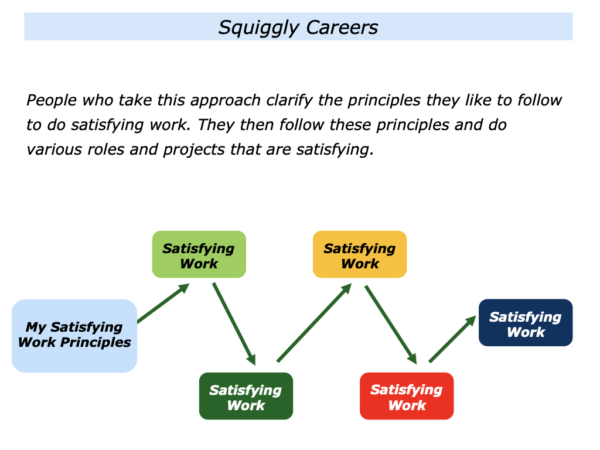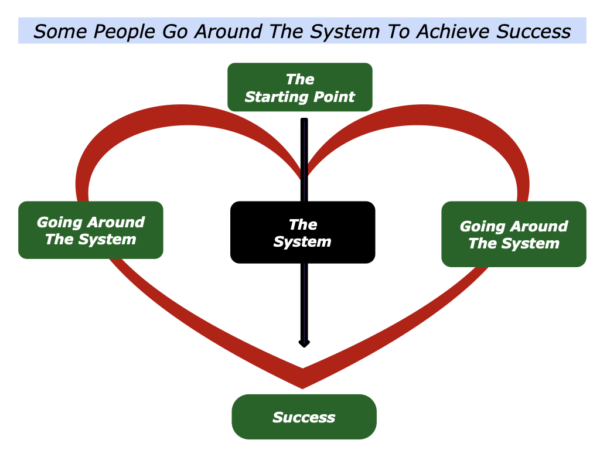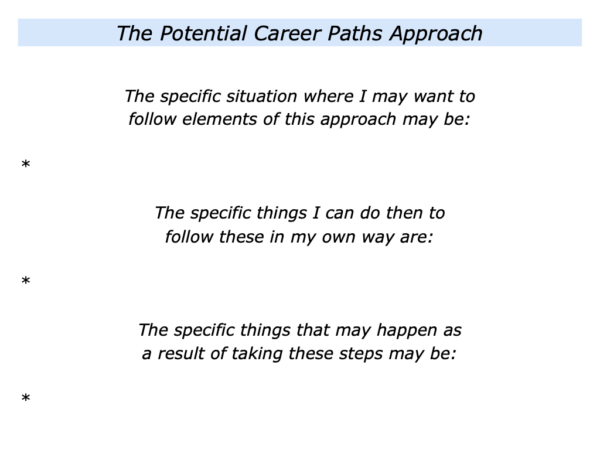
There are many ways that people can shape their careers. Imagine that you want to help people to see some of these possibilities. If appropriate, you may want to describe the following potential career paths.
The Strengths Approach
This approach involves a person building on their strengths and doing satisfying work. Imagine that a person wants to follow this route. This may involve them being helped:
To find and build on their strengths;
To find and do satisfying work where they can play to their strengths;
To continue to build on their strengths and, when appropriate, find or create other opportunities where they can do satisfying work.
Some people are able to take this route by themselves. As mentioned earlier, however, some may need help to find or create the opportunities where they can continue to pursue this career path.
The Straight Line Approach
This is the traditional career path. It involves a person going in a relatively straight line as they develop their career. It also used to be a reasonably predictable route. But nowadays unexpected events can create challenges.
A person who follows this route may start by aiming to do well academically. They may then join an established company, climb the ladder and reach the C-Suite.
Another person who follows this route may go into an established profession. They may go into medicine, the law, financial services or another field. They may continue to gain qualifications and perhaps specialise in their area of expertise.
The Salary And Status Approach
This is a route followed by some people. They seek roles based on: a) the salary; b) the status it will give them. These factors can become an obsession as they go through their careers.
Such people may also compare themselves with others. They may measure their progress in relation to what others in their age group are doing. This does not necessarily help their wellbeing.
The Stimulating Projects Approach
Some people aim to build on their strengths and do stimulating projects. Such people have a freelance mentality. They recognise there are now fewer predictable career paths but there are many potential projects.
Bearing this in mind, they aim to find or create such projects. These may be in certain fields – such as health care, local government, digital or other areas. They aim to contribute to these projects and deliver success.
Such professionals aim to continually deliver high standards. They recognise that satisfying the key stakeholders can lead to getting more work on future projects.
They also keep in touch with people in their network. Clarifying the challenges that these people face, they offer knowledge that these people can use to achieve success. Sometimes this leads to opportunities for future work.
The Squiggly Approach
Some people pursue squiggly careers by doing roles that appear different. But the people who take this route often embody two themes.
They clarify the principles they like to follow to do satisfying work.
They then follow these principles and do various roles and projects where they can do satisfying work.

Mitch Joel talked about squiggly careers in his book CTRL ALT Delete. Here is a short introduction to his view of this approach.
Embrace The Squiggle
In the second half of the book, I talk about the value of having a squiggly career. I explain:
How the most interesting and successful people I know didn’t have a very linear trajectory;
How it will not be uncommon for many of us to have 4-5 different careers in our lifetime (as opposed to 4-5 different jobs in our careers).
Too many people feel trapped and compelled to stay the course. Too many people think that a linear career is the prudent and true path.
Squiggly is interesting. Squiggly is better.
The Serendipity Approach
Some people experience the serendipity approach. They seem to fall into roles as if by chance. This approach can take many forms but here is one example.
Eric was finishing a degree in chemistry and aimed to pursue this as a career. During his final year he visited a friend who invited him to a trade fair where companies where looking to hire graduates.
Accompanying his friend, Eric became interested in a particular stand at the exhibition. The company was demonstrating a new technology that would diagnose illnesses at an earlier stage.
The representative for the company invited Eric to try the technology. This led to further discussions and him joining the business.
Eric went on to become the head of sales and, eventually, the CEO. He was then focusing on a different kind of chemistry. This involved coordinating people’s talents to achieve success.
There are many examples of serendipity striking to take people in different directions. Such chances can also lead to deeply satisfying careers.
The Going Around The System Approach

This is an approach followed by people who may be considered to be deviants – but they also deliver. They may do this by being creative, being entrepreneurs or by going around the system to achieve success.
Such people are often lifelong learners and have a pattern of following their own path. Some may have been good academically. But others may have preferred to learn in their own way.
Some may have pursued a passion where they have the ability to deliver peak performance. They may then have taken the following approach.
They may have focused on a stimulating goal – such as inventing a product, building a business or having another picture of success;
They may have found creative ways to go around the system – rather than through it – and explored different routes to delivering success;
They may have learned from experience and failures before establishing credibility and achieving their picture of success.
Such people continue to be curious. They love to follow their passions, do stimulating work and achieve success.
Let’s return to your own life. Can you think of a situation where you may want to follow some elements of the potential career paths approach? This could be in your own work or helping others to develop their careers.
If you wish, try tackling the exercise on this theme. This invites you to complete the following sentences.







Leave a Reply